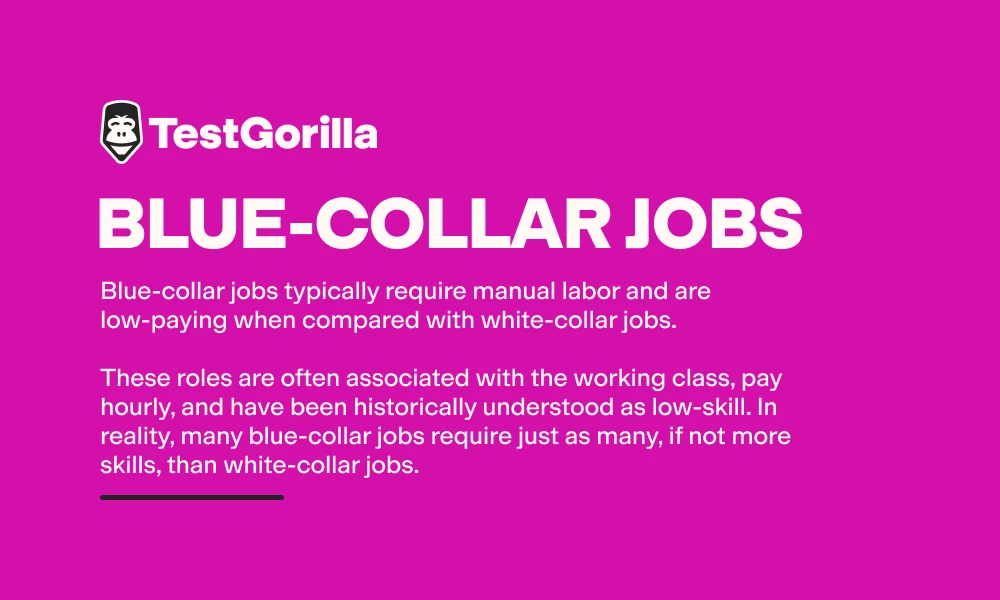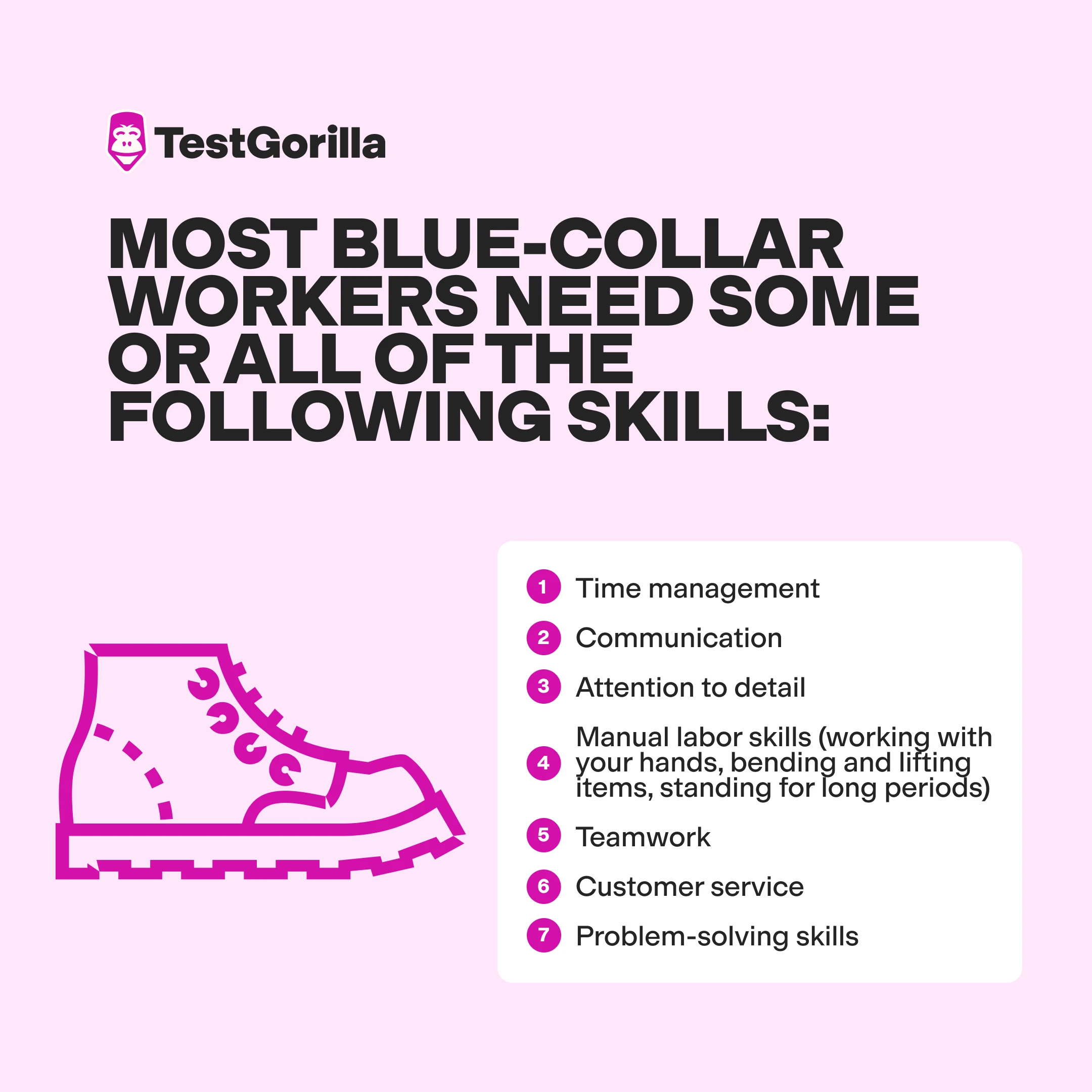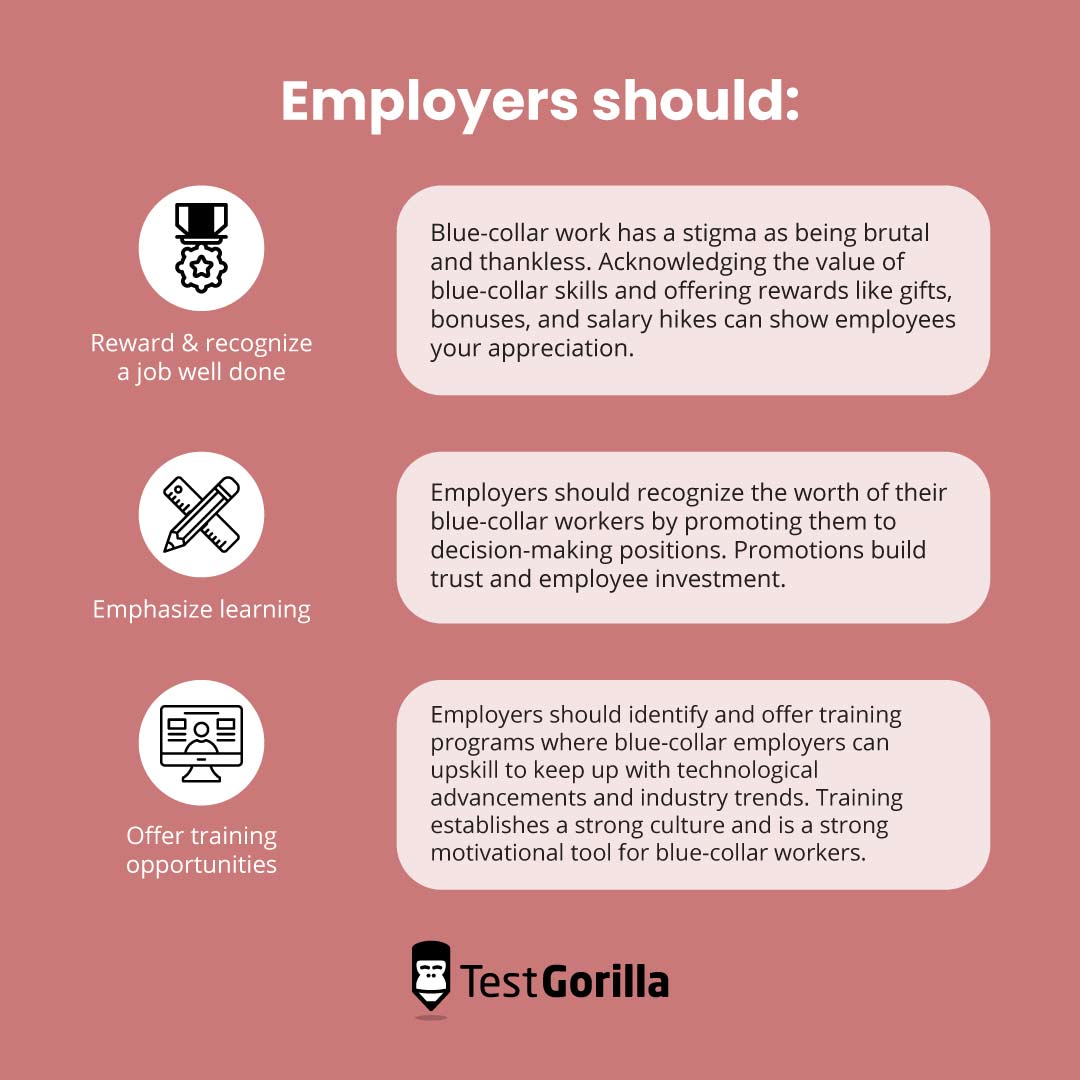Employers are finding it increasingly difficult to fill their blue-collar job openings. The Covid-19 pandemic and the Great Resignation have contributed to this hiring shortage, but attracting and retaining skilled blue-collar workers was an issue even previously.
With older workers retiring and many younger workers opting for four-year degrees or white-collar work, companies need to adjust their blue-collar recruitment strategies.[1]
Skills-based hiring locates talented workers by focusing on skills instead of education and prior job experience. Using skills assessments and structured interviews, and investing in upskilling and employee development, are all ways to take a skills-based approach to blue-collar recruitment.
This article contains everything you need to know about taking a skills-based approach to blue-collar recruitment.
Table of contents
- What is blue-collar recruiting?
- Is skills-based hiring the right choice for blue-collar recruitment?
- 6 ways to improve blue-collar recruitment
- Skills to look out for during blue-collar recruitment
- 8 steps for successful, skills-based, blue-collar recruitment
- Blue-collar recruitment case studies
- Master blue-collar recruitment with skills-based hiring
What is blue-collar recruiting?
Blue-collar recruitment is the process of recruiting workers for blue-collar jobs. Blue-collar jobs typically require manual labor and are low-paying when compared with white-collar jobs. These roles are often associated with the working class, pay hourly, and have been historically understood as low-skill.
Examples of blue-collar jobs
The following industries contain the most blue-collar jobs:
Construction
Manufacturing
Retail
Hospitality
In reality, many blue-collar jobs require just as many, if not more skills, than white-collar jobs. Masons, for example, must be physically skilled to lift heavy materials and build structures out of stone, concrete, and tile. They can also read blueprints and technical drawings, assist in building layouts, operate complex equipment, train others, and show soft skills like problem-solving, communication, and math.
Masons arguably have more high-level skills than a white-collar data-entry clerk.
Although some blue-collar jobs pay low wages, many blue-collar workers are experiencing a job wage boom due to a tightening labor market and employee upskilling to meet growing technological advancements.
Is skills-based hiring the right choice for blue-collar recruitment?
The blue-collar job market faces several challenges. Locating skilled talent is chief among them.
According to the Adecco Group, it is now harder to find blue-collar employees than white-collar employees. For example, 80% of construction firms report they have a hard time filling hourly craft positions.[2]
Keeping skilled talent is also a concern for employers. Many workers are leaving their blue-collar jobs to move to lower-cost cities, pursue degrees, or transition to new-collar jobs – tech jobs that don’t require a degree.
According to Deloitte, only about a quarter of workers (27%) strongly agree that employers are making progress when hiring for skills and investing in employee development. More than half of workers (64%) say they would be more likely to join and remain at an organization that values their growth and offers skills training.
Skills-based hiring is more effective for hiring and retaining blue-collar workers than traditional hiring methods because it addresses these concerns by prioritizing skills.
Skills-based hiring strategies also expand the talent pool to include candidates from all backgrounds to assess skills and invest in upskilling and development plans. This investment ensures candidates that their career path is an organizational priority.
The evidence is clear. Our report, The State of Skills-Based Hiring 2022, found that 91% of companies that used skills-based saw increased workplace diversity, with 72.1% of employees reporting they are happy in their roles.
6 ways to improve blue-collar recruitment
Sure, skills-based hiring sounds good in theory. But how do you put it into practice to fill blue-collar jobs? Here are some key actions to take:
1. Emphasize skills on your job postings
A participant in a McKinsey study found that prioritizing skills on job postings quadrupled the number of applicants after a week.
2. Target candidates with cross-skill potential
Hiring candidates who can perform multiple roles widens the talent pool for workers with transferable skills from different industries.
3. Recruit diverse candidates
Resumes and cover letters are bias-prone hiring metrics that do not predict job success and stifle innovation. By eliminating these archaic requirements, diverse talent can enter the process. Overcoming bias increases creativity, eliminates groupthink, and strengthens organizational culture.
4. Use skills tests and pre-employment assessments
Evaluate the hard and soft skills of candidates with role-specific tests, cognitive ability tests, and personality tests. These assessments are a great screening tool to use at the earliest possible stage of hiring.
5. Eliminate unstructured interviews
Free-flowing interviews are poor job performance predictors prone to bias. Companies like UPS, Home Depot, and GAP have dropped some of these interview requirements. If you must interview, go with structured interviews instead.
6. Double down on retention
But how do you keep blue-collar employees once you hire them? Let’s use retail as an example.
According to McKinsey, flexibility is the most pressing issue for frontline retail employees. Retailers can offer flexibility to their blue-collar workforce in four ways:
Give employees options to increase or decrease their hours to accommodate other part-time jobs
Allow employees to work at other store locations on particular days that best fit their travel needs
Give employees more control over how their work gets done
Offer development opportunities
Skills-based hiring can meet each of these goals by:
Hiring qualified candidates to increase efficiency: More talent in the workplace means work gets done quicker, and employees can log fewer or more hours depending on their responsibilities
Testing transferable skills: Skills-based hiring can test transferable skills regardless of the storefront or job site.
Encouraging innovation: Enabling employees to use their skills to innovate is a core principle of skills-based hiring. Encouraging employees to optimize procedures and take charge of tasks saves managers time and employers money and empowers their workforce.
Emphasize upskilling: Investing in your people can address skills gaps, increase innovation, and establish a strong company culture.
Skills to look out for during blue-collar recruitment
Most blue-collar workers need some or all of the following skills:
Time management
Communication
Attention to detail
Manual labor skills (working with your hands, bending and lifting items, standing for long periods)
Teamwork
Customer service
Problem-solving skills
There are always a number of skills that contribute to strong job performance in any role. A construction worker, for example, needs to know how to work well within a team, solve mechanical or organizational problems that could arise on-site, and have excellent vision and depth perception.[3]
A server needs to have customer service skills, be able to bend and lift items, and be able to communicate menu items and culinary information.
Testing for blue-collar skills
Multi-measure skills testing is the best way to evaluate a variety of common hard and soft skills across blue-collar and white-collar industries. Using premade assessments or designing tests can identify specific skills quickly and affordably.
TestGorilla has developed many online blue-collar skills tests, such as:
Warehouse Supervisor test
Hospitality tests
Equipment Maintenance tests
Fundamentals of Electricity tests
Mechanic Reasoning test
Time Management test
All of these tests, and more, are available in our skills test library.
If you want to assess the personality traits and interpersonal skills of candidates, you can ask behavioral interview questions for blue-collar recruitment. Here are some examples:
Was there a time when you went above and beyond to satisfy a client? Can you explain how?
When was the last time you made a grave error in judgment? How did you communicate this to your team and/or manager?
These questions give you insight into the candidate’s critical thinking skills and interpersonal style. Their answers inform how candidates behave in certain situations and predict how they perform in the role.
8 steps for successful, skills-based, blue-collar recruitment
This section explains how to use pre-employment assessments, behavioral interviews, and job simulations to fill a blue-collar job: a retail associate position.
Some steps are more involved than others, but they are all important for filling blue-collar roles with skilled workers. For a general overview of skills-based hiring best practices, check out our guide.
Step 1: Choose a handful of roles
It’s important to note that you do not have to redefine your entire hiring strategy to implement skills-based hiring practices.
First, try identifying a handful of roles that have:
High turnover rates
Emerging skills
Longest time-to-hire
Skills-based hiring can address your high-turnover positions, like cashiers, for example. It can also locate talent with emerging skills, like electric vehicle mechanics who have in-demand expertise working on high-voltage battery and electric motor vehicles.
The retailer needs an associate who can interact with customers, sell apparel, have knowledge about the business and the product, and be able to do simple math.
This retail associate position typically has the longest time-to-hire.
Step 2: Find the skills gap
Skills gaps are the difference between your workforce’s skills and the skills your employees need to meet your organizational goals.
Conducting a skills-gap analysis can help you determine where your business needs talent and improvement.
The retailer notices that customers are entering the store but not buying anything. A skills analysis reveals that the skills gap is related to customer service, sales, and cultural and product awareness.
In other words, the retailer’s current retail associate lacks key retail skills when it comes to being helpful, friendly, patient, and knowledgeable about the clothing and the brand.
Step 3: Identify a role to recruit for and establish core skills
Now that the retailer has conducted a skills-gap analysis, it can determine the core abilities of the new hire.
The best way to gather information to establish core skills is to consult with your other employees, managers, and team leaders. The people who make your organization function every day are an invaluable resource. And there’s a bonus: Providing multiple ways for employees to share their thoughts improves team unity and performance.
After speaking with multiple employees from different departments, the retailer uses its findings and data from the skills-gap analysis to build a role that meets its organizational needs: a new retail associate position.
Step 4: Use skills-based job descriptions
Communicating effectively to candidates through job postings is paramount. Job listings and advertisements are often the only way employers can inform skilled candidates about their job openings.
That’s why you can’t waste an opportunity to show candidates that you care about their skills and value their development.
Your job descriptions should meet the following requirements:
Requirement | Why it matters |
List skill requirements, not education requirements | Emphasizing skills and eliminating unnecessary requirements immediately increases engagement with your job postings. |
Advertise employee development opportunities | Investing in upskilling and employee growth helps you keep new hires for the long term. |
Offer payment for job trials, if applicable | If you want to offer a job trial for a candidate, make sure that you offer compensation to show you’re willing to invest upfront. |
Promote other positive benefits of the job | For example, explain how a candidate’s cultural knowledge, clothing expertise, and fashion sense help them forge connections with their customers. |
Be mobile-friendly | Research shows blue-collar workers are more likely to use mobile phones to look for jobs than other workers. Mobile-friendly job openings can increase the number of applicants. |
Veterans are also a great talent pool if you’re looking for skilled workers.
Military veterans, for example, have experience in the supply chain, construction, driving, communication, time management, and leadership skills.
Advertising to candidates with transferable skills, like veterans, is a great way to attract qualified candidates and fill your openings with diverse talent.
Step 5: Use screening tests to find candidates with the right skills
Retail jobs are often high-pressure positions requiring a blend of hard and soft skills to cater to customers, boost sales, and maintain products. These skills include:
Perseverance
Attention to detail
Customer service
IT skills
Sales skills
Time management skills
You can find a complete list of top retail skills here.
Many retailers use skills assessment tests. The Walmart Retail Associate Assessment measures a candidate’s ability to handle customer interactions and to work under supervisors and within teams.[5]
For this example, the employer can choose to implement similar tests, like the:
Skills test | Why you should pick it |
To assess a candidate’s understanding of customer inquiries, interaction, and use of appropriate language to achieve an efficient resolution | |
To evaluate a candidate’s ability to build a connection with customers in a sales environment and test product knowledge and personal communication skills | |
To handle multiple transactions, perform basic math, and have the potential to upskill into a position where inventory and finance skills could be required |
Once candidates complete the tests, they are ranked by skill level, regardless of their work experience or education history.
Candidates can complete these assessments online, so you don’t need to look at cover letters or resumes.
Step 6: Run structured interviews and job simulations
When top contenders emerge from the successful job posting and skills test phases, employers should invite them to participate in a behavioral interview.
Most interview processes are flawed and run expensive, time-wasting unstructured interviews that do not assess skills and expose the process to bias.
Structured interviews are more formal interviews that ask pre-established questions in a particular order.
This method scores and grades interviewees on a scale, eliminating bias in determining the outcome.
For example, in a structured, behavioral interview, the retail employer can ask customer services questions related to:
Quality and culture
Empathy and communication
Problem-solving
Once these interviews conclude, you have a far better understanding of who to hire for the new retail associate position.
Job simulations give employees the opportunity to carry out tasks that would be part of their daily routine in your organization. These assessments can take place in person or remotely and can be as simple or involved as necessary.
For example, a simulation could require an electrician to define terms and concepts relevant to the role, or arrive onsite for a lighting installation. Or, if you’re looking to hire a gardener, you could ask them to explain their process for choosing plants that would thrive in a local garden.
For example, you can use fun puzzle and math games for sales representatives and cashiers, or role-playing games that simulate scenarios like how to handle difficult customers.
Structured interviews and job simulations save time and money and ensure that the candidate has the skills to handle customers, represent the brand’s vision, and have appropriate cultural knowledge about clothing and products.
Step 7: Apply skills-based hiring steps to more open positions
Now that the retail employer successfully filled an open position, it can begin this process for other jobs.
The retail associate position was an entry-to-mid-level position. Perhaps the employer wants to expand this skills-based hiring approach to understand and fill management skills gaps.
Ultimately, skills-based hiring can expand the talent pool, boost brand image, and reduce costs in addition to growing your business.
Step 8: Offer and advertise training and development opportunities
Communicating to blue-collar workers that they have room to develop within your organizational structure is crucial to filling and retaining positions.
Many candidates believe that blue-collar jobs have a ceiling. However, a variety of blue-collar skills can transfer into so-called white-collar roles, and many of the distinctions we place on these roles are often arbitrary.
Communicating to your candidates and employees that they are more than high-level or low-level workers can decrease turnover and increase job satisfaction.
Employers should take the following actions:
Action | Why it matters |
Reward and recognize a job well done | Blue-collar work has a stigma as brutal and thankless. Acknowledging the value of blue-collar skills and offering rewards like gifts, bonuses, and salary hikes can show employees your appreciation. |
Emphasize learning | Employers should recognize the worth of their blue-collar workers by promoting them to advance to decision-making positions . Promotions build trust and employee investment. |
Offer training opportunities | Employers should identify and offer training programs where blue-collar employers can upskill to keep up with technological advancements and industry trends. Training establishes a strong culture and is a strong motivational tool for blue-collar workers. |
Read our guide to learning and development to discover other ways to support your employees as they build their careers.
Blue-collar recruitment case studies
A skills-based hiring approach does not discriminate against talent. Instead, it expands access to it. Open hiring is an example of how moving away from archaic requirements like resumes, cover letters, and degrees to invest in skills can open up the talent pool and tear the paper ceiling.
Greyston Bakery
Greyston Bakery in Yonkers, NY, offers jobs based on a queuing system: Whoever is willing and able to work, and is next in line, gets the job. When cutting out requirements, background checks, and drug tests, you have no hiring costs.
Greyston takes the money it would have spent and invests about $1,900 in hard and soft skills training for new bakers.
The bakery also connects employees to health, housing, and childcare services, saving the local community more than $7m through public assistance savings, increased tax revenue, and reduced incarceration.
Opening up the talent pool to non-traditional worker populations and investing in their skills development is one of the many ways that skills-based hiring can fill blue-collar job openings and save employers money.
Patty Garcia
Patty Garcia is another example. Garcia started as a lineworker for CPS Energy in 1988, where she helped manually install underground gas pipes to heat people’s homes.
Although most STEM jobs are white-collar, Garcia’s work is classified as skilled-technical STEM work and is under the blue-collar umbrella. Her job did not require a degree, and she was consistently upskilled by her employer.
She says: “[The company] gives you the opportunity to get trained. They guide you, and they give you the opportunity to grow within the company – that’s why I jumped on the bandwagon.”
After five years, Garcia earned a promotion to a gas trainee in the construction department. She helped supervisors map new infrastructure and secured tools needed for each job.
She got her commercial driver’s license, enabling her to operate large machinery, and learned how to lead teams. She’s been a foreman for more than two decades. Her employer implemented many skills-based hiring practices including:
Filling an entry-level position with a candidate who showed growth potential.
Hiring for culture add (only 3% of first-line supervisors in construction are women)
Emphasizing and showing a commitment to upskilling (she was frequently trained and rewarded for her development)
Focusing on retention (The business identified her as a valuable blue-collar worker and facilitated her growth, treated her with respect, acknowledged her skills, and promoted her to decision-making positions).
Skills-based hiring benefits employers and workers alike, regardless of how they begin their careers.
Master blue-collar recruitment with skills-based hiring
Skill-based hiring fills blue-collar positions by eliminating resumes, education requirements, and unstructured interviews wherever possible and focusing on upskilling, recognition, and rewards for hard work. Skills tests, behavioral interviews, and job simulations are helpful tools to widen the talent pool and hire skilled blue-collar workers for the long term.
Following the best practices for hiring blue-collar workers is a great way to get started with skills-based hiring for all levels of your organization. You can also read our guide to pre-employment skills testing for a deeper look into the benefits of skills testing.
Sources
1. Boyle, John. (May 2, 2019). “Good-paying blue collar jobs go unfilled in tight labor market”. The Citizen-Times. Retrieved April 17, 2023. https://www.citizen-times.com/story/news/local/2019/05/02/good-paying-blue-collar-jobs-go-unfilled-tight-labor-market/3590947002/
2. “Eighty Percent of Contractors Report Difficulty Finding Qualified Craft Workers to Hire as Association Calls for Measures to Rebuild Workforce”. (August 29, 2018). Associated General Contractors of America. Retrieved April 17, 2023. https://www.agc.org/news/2018/08/29/eighty-percent-contractors-report-difficulty-finding-qualified-craft-workers-hire
3. “5 Key Qualities of Skilled Construction Workers”. (December 7, 2020). Tradesmen International. Retrieved April 18, 2023. https://www.tradesmeninternational.com/news-events/critical-construction-labor-skills/
4. Zhao, Daniel. (June 3, 2019). “The Rise of Mobile Devices in Job Search: Challenges and Opportunities for Employers”. Glassdoor. Retrieved April 17, 2023. https://www.glassdoor.com/research/mobile-job-search/
5. Evangelisti, Gianni. (n.d.). “Walmart Assessment Test”. Test-guide.com. Retrieved April 17, 2023. https://www.test-guide.com/walmart-assessment-test.html
Related posts
Hire the best candidates with TestGorilla
Create pre-employment assessments in minutes to screen candidates, save time, and hire the best talent.
Latest posts
The best advice in pre-employment testing, in your inbox.
No spam. Unsubscribe at any time.

Hire the best. No bias. No stress.
Our screening tests identify the best candidates and make your hiring decisions faster, easier, and bias-free.
Free resources
This checklist covers key features you should look for when choosing a skills testing platform
This resource will help you develop an onboarding checklist for new hires.
How to assess your candidates' attention to detail.
Learn how to get human resources certified through HRCI or SHRM.
Learn how you can improve the level of talent at your company.
Learn how CapitalT reduced hiring bias with online skills assessments.
Learn how to make the resume process more efficient and more effective.
Improve your hiring strategy with these 7 critical recruitment metrics.
Learn how Sukhi decreased time spent reviewing resumes by 83%!
Hire more efficiently with these hacks that 99% of recruiters aren't using.
Make a business case for diversity and inclusion initiatives with this data.






















